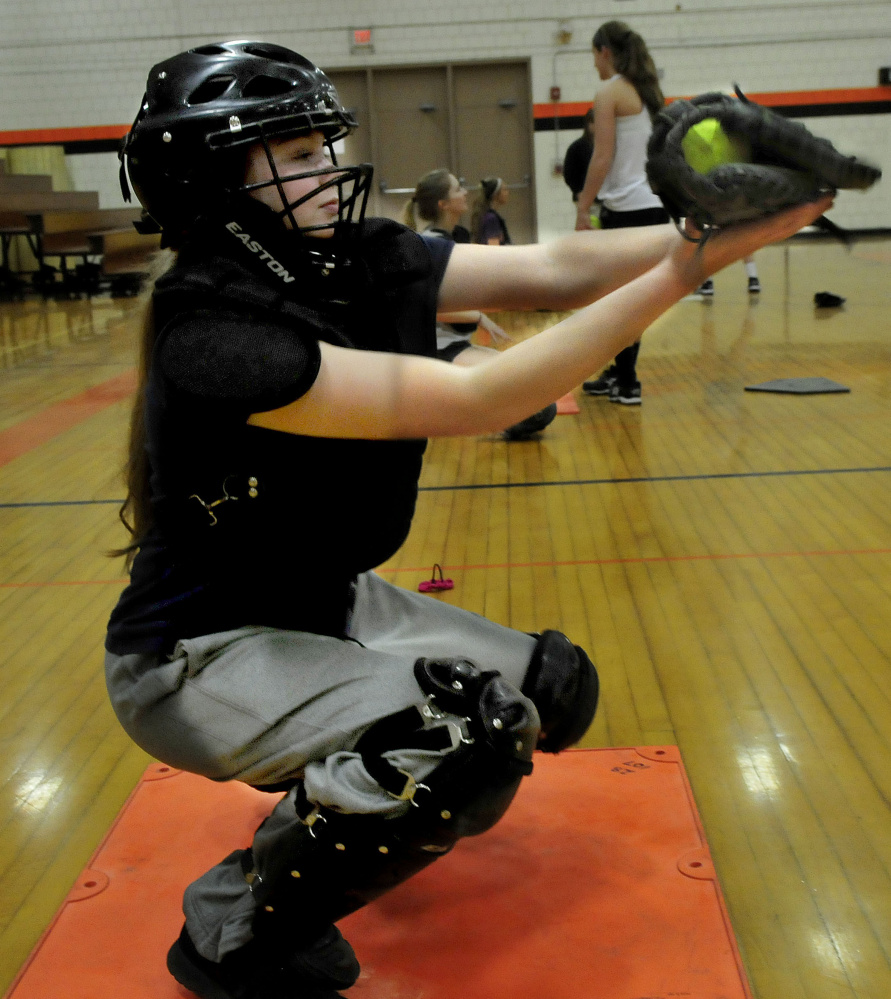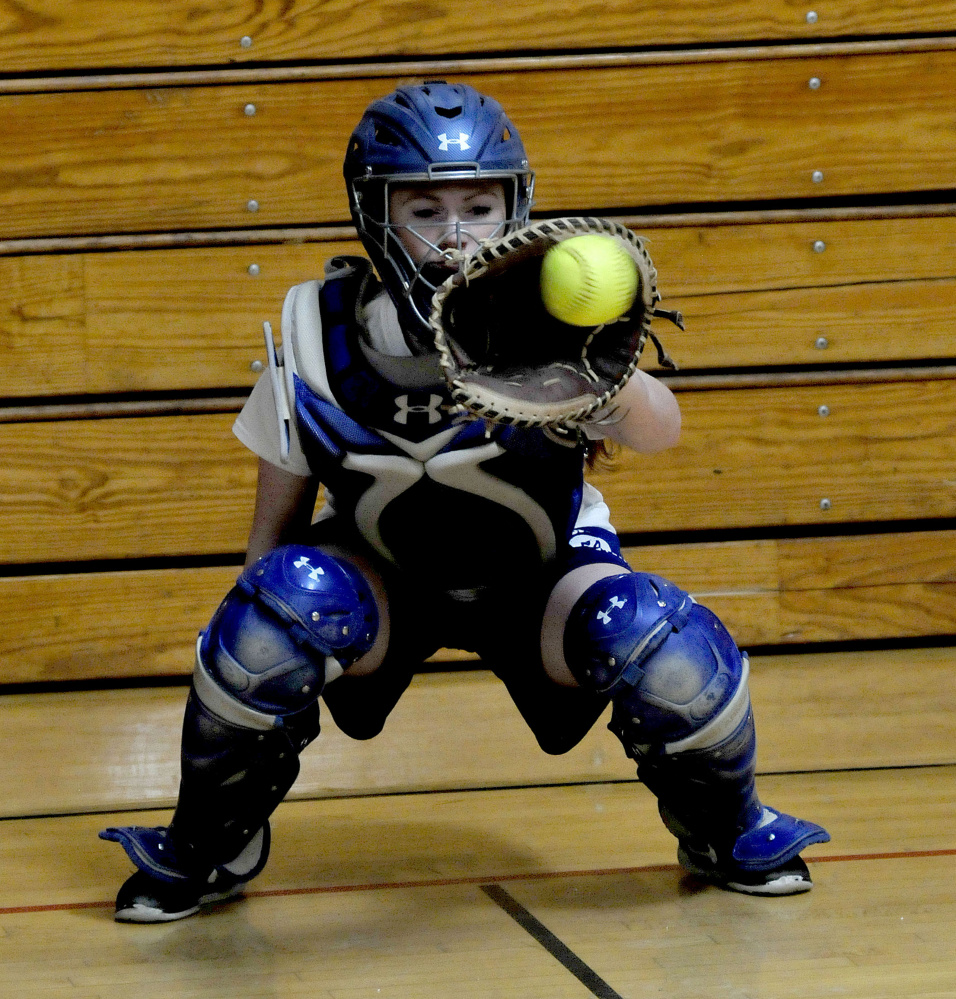So intense is the focus on the pitching circle in high school softball, oftentimes the position on the diamond that is just as crucial is completely overlooked.
Make no mistake, though, coaches know just how critical the catcher is to a team’s success.
“If you have a fantastic pitcher but you don’t have a catcher who can handle her, it’s almost useless,” Oak Hill head coach Allyson Collins said.
“I’ve always felt like they’re the extension of the coaches,” said Madisona Area Memorial High School head coach Chris LeBlanc. “Whether it’s a freshman or a senior that’s starting, I tell them that they’re in charge of that field when they go out there.”
Catchers, like pitchers, are involved in every single pitch — in every single moment — that shapes softball games. They flash signs, catch pitches and command the defensive alignment in a game where offenses try to manufacture single runs with steals, bunts, slaps and hit-and-run plays. All of those tactics put pressure on a team’s defense, which is commandeered by the catcher.
Without an above-average catcher, most teams are already well behind the rest of the pack.
“I agree, for many reasons,” Skowhegan Area High School head coach Lee Johnson said. “One, they understand the pitchers pretty well, even from a mechanical standpoint. They know what to look for even as far as some of the flaws they might have in their delivery. They’re out there calling cutoffs, helping out with how we should be working batters, and they do a lot of those little things during the course of a game.”
Skowhegan is blessed with two very good catchers, in Julia Steeves, a junior, and Sydney Reed, a sophomore. Both Reed’s father and her aunt — Indians assistant coach Kim McEwen — were both catchers during their collegiate careers at the University of Maine.
The common thread weaving its way through the collective thinking of area coaches this spring is wanting to build teams that are athletic and less specialized, creating rosters where players provide lineup flexibility by being able to play several positions.
The line in the proverbial sand, however, is drawn at the battery.
“You don’t want them to only know how to play one position,” veteran Lawrence High coach Joey Marcoux said. “If there’s a (varsity) player ahead of them, then they might not have a chance at that position until their senior year — and that means a kid might not play.”
Marcoux stops when it comes to pitchers and catchers.
“Pitcher and catcher, though, are a bit of a specialty,” he said.
More than a bit, actually.
While its generally well-known that pitchers work year-round on their craft with personal trainers and coaches, that the same holds true for catchers might come as a bit of a surprise to casual observers.
Oak Hill senior Emma Hlister, an All-Mountain Valley Conference catcher last season, works with a personal catching coach twice a week during the offseason and once a week in-season.
“There’s a lot of training,” Hlister said. “I work my legs, to make sure I can block (pitches in the dirt) and get back up without using my hands, and I work on my throws. Basically, it’s everything a catcher does.”
The evolution of offseason programs seems to simply have grown as an obvious offshoot to offseason programs for pitchers. Many pitchers are asked to bring a catcher with them to their throwing workouts.
It creates a relationship that is fostered for an entire year. In some cases, pitcher and catcher work together for years.
“If you want to be a premier catcher, if you want to play after high school, catchers need that same experience (as pitchers),” Collins said. “It’s not just pitchers getting training anymore. Catchers have their personal trainers, as well. It’s become much more of a primary position.
“Where it used to just be about pitchers, now catchers are getting the attention they deserve.”
With that attention comes criticism.
LeBlanc admits that he’s harder on his catcher than on any other position on the field. If you’re going to serve as an extension of the coaching staff, then there must be accountability when things don’t go according to plan.
“Communication is huge,” said LeBlanc, who will begin this season with the Bulldogs’ leading hitter and two-year starter at second base, Ashley Emery, making the switch to the catching position. “They have to have broad shoulders and be able to take constructive criticism. I’m not only going to get on them when they make a mistake, but I’m going to get on them, too, when someone else makes a mistake. The catcher is the one making calls to do certain things defensively. If the ball is hit and we don’t know where to go with it, I’m looking at the catcher.”
“You need someone out there that knows the game better than anyone else,” Collins said. “They need to know where they’re going with the ball. They have control of the infield. Pitchers have enough to think about with their pitching and their form and all of that. Catchers aren’t just there to catch the ball, they’re there to run your infield.”
As it turns out, LeBlanc and Collins are hardly anomalies. Johnson places so much trust in his catchers that oftentimes he gladly lets them do some of the heavy lifting.
“From my standpoint, there’s many times I could call a timeout and go out and talk to the pitcher myself, but I can give (the catcher) a signal and have her go out and talk to them,” Johnson said. “It’s because they have that relationship already.”
And that relationship is key to a team’s success, from the time the catcher flashes the first sign to signal for the first pitch of the game.
Travis Barrett — 621-5621
tbarrett@centralmaine.com
Twitter: @TBarrettGWC
Send questions/comments to the editors.






Comments are no longer available on this story